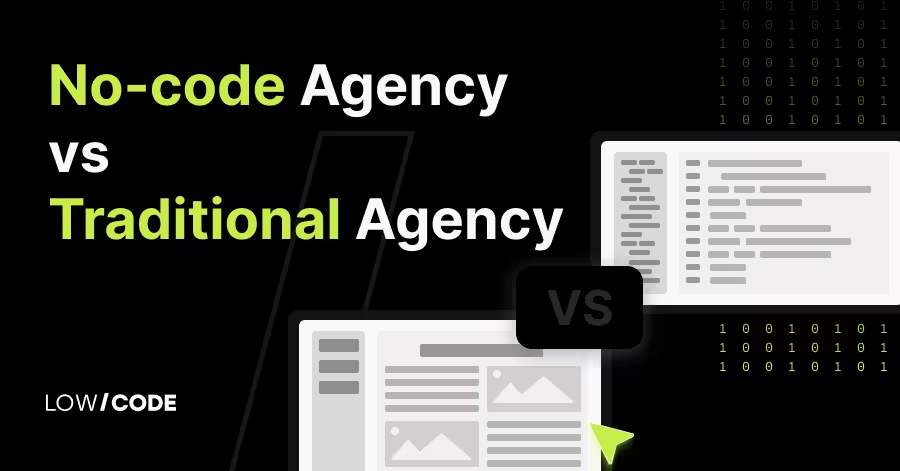Why no-code? The benefits of no-code development
6 min
read
Learn all about the benefits of development with no-code platforms: intuitive, secure, and cost-effective software creation.

You've heard about no-code, but do you know what it truly means and how it's transforming software creation? No-code development is revolutionizing our approach to software.
Even though no-code platforms have been around since the early 2010s, their popularity has significantly increased in recent years as a result of significant advancements in their capabilities and accessibility. In this article, we'll dive into the world of no-code, discover its benefits for projects of all sizes, and unveil its game-changing potential.
TL;DR
No-code platforms offer a streamlined approach to application creation with intuitive visual development interfaces. They enable quick iterations, prototyping, and testing, making development faster and more responsive to user needs. Beyond speed, they also simplify maintenance, enhance cost-effectiveness, and offer built-in security, offering a comprehensive solution for efficient software development.
What is no-code development?
No-code development is a revolutionary approach to software creation that empowers individuals to design and deploy applications without the need for traditional coding. It makes the development process both faster and more accessible.
Users don't have to write detailed lines of code, because no-code platforms provide a simplified, visual development interface. This visual approach allows users to develop applications by assembling pre-built elements, such as components, forms, and workflows. Instead of coding logic with intricate scripts, users can design them graphically. For example, they can define if-then-else conditions, create data workflows, and establish connections between different parts of the application, all through visual representations.
These are the key elements at the core of every no-code platform:
- Visual development: No-code platforms typically feature visual, user-friendly interfaces that allow users to design applications through drag-and-drop components, forms, and workflows. Instead of writing code, users create applications by configuring pre-built elements and logic.
- Pre-built templates and components: No-code platforms often offer a library of pre-designed templates, modules, and components that users can leverage to build applications more efficiently. Templates can cover a wide range of use cases, from data collection forms to complex database-driven apps.
- Integration capabilities: No-code platforms' integration capabilities allow users to easily connect their applications to external services, APIs, and databases. Users can connect to third-party software systems like CRM tools, payment gateways, cloud services, and data repositories. No-code apps can work in harmony with existing technology ecosystems and have expanded functionalities thanks to integrations.
- Maintenance and updates: No-code platforms typically handle routine maintenance tasks, such as security updates and bug fixes, automatically. This reduces the burden on users to maintain and troubleshoot their applications continually.
No-code platforms are essentially services that provide users with an environment to develop software solutions. Users select a specific no-code platform depending on their project's requirements. For example, each platform typically specializes in certain types of developments, such as websites, mobile apps, or web applications
Users typically subscribe to these platforms and pay for their services, depending on the platform and usage. In addition to offering development capabilities, many no-code platforms also provide hosting services, allowing users to deploy and run their applications.
No-code benefits

Faster development
The initial and most evident advantage of no-code? Speed. Visual development is at the core of this speed advantage. No-code platforms replace lines of code with a visual interface that allows for intuitive design and assembly. Applications are created by dragging and dropping components, forms, and logic, instead of wrestling with intricate code.
No-code platforms also offer libraries with pre-designed templates, modules, and components. These resources cover a vast array of use cases, from data collection forms to complex database-driven apps, and can be used directly, so you can skip extensive custom development.
Cost-effective
No-code app development offers a cost-effective solution for creating software applications. Unlike traditional software development which can involve substantial expenses, including hiring experienced developers and allocating resources for coding, testing, and debugging, no-code development provides a more predictable cost structure.
Even if you decide to hire no-code experts to assist you, the final price is typically more transparent and manageable. Additionally, many no-code platforms offer all-in-one solutions that encompass maintenance, security, and other potentially expensive aspects, making it a financially attractive option.
The faster time-to-market and cost cuts translate into increased Return on Investment (ROI) for businesses. You can start reaping the benefits of your software investment sooner."
Flexibility and iterations
No-code platforms offer unparalleled flexibility in software development. With traditional coding, making changes to an application often involves rewriting extensive lines of code, which can be time-consuming and error-prone. In contrast, no-code lets you modify designs, functionalities, and logic with ease, ensuring your software remains aligned with evolving business needs and user feedback.
Flexibility is especially important because iterations play a significant role in any development process. Being able to create prototypes, gather user feedback, and implement changes quickly accelerates the evolution of your application.
It enables you to respond promptly to user preferences and market demands. With no code, the iterative approach becomes seamless, fostering a culture of continuous improvement. It ensures that your software remains competitive and aligned with your objectives.
Integration capabilities
Modern businesses rely on a multitude of tools and software applications to operate efficiently. No-code platforms typically offer seamless integration with various third-party services and APIs. You can easily connect your no-code app to popular software like CRM systems, payment gateways, and analytics tools.
Integrations can help you maximize the value of your existing tech stack with tailored, interconnected solutions that complement your established workflows. For example, if you're using a CRM system to manage customer relationships and want to create a custom front-end interface, a no-code app can be designed to fetch, update, and display data from the CRM.
Easier maintenance
No-code platforms not only simplify the initial development process but also streamline ongoing maintenance, reducing the burden on your organization.
Traditional software maintenance often involves managing updates, bug fixes, and security patches, which can be time-consuming and require technical expertise. No-code platforms typically handle routine maintenance tasks automatically. You no longer have to worry about tracking and applying updates manually because the platform takes care of keeping your applications up to date, ensuring they remain secure and compatible with the latest technologies.
Maintenance downtime can disrupt your operations and impact user experience. No-code platforms often employ strategies like staged updates and redundancy to minimize downtime during maintenance. So, your applications will remain accessible and operational even when updates are being applied.
Security
With no code, you don't have to worry about the complexities of securing your applications; it's an inherent part of the platform's design. They implement robust security measures, including features like data encryption, user authentication, and role-based access control.
The platforms continuously update their security measures to stay ahead of emerging threats. A proactive approach ensures that your applications remain safeguarded against evolving security risks without requiring you to monitor and apply security updates manually.
Furthermore, if you opt for full-stack no-code platforms, you can benefit from server management services, which include server maintenance, scalability, and load balancing—all essential components for keeping your applications running smoothly and securely.
Other benefits
While entrepreneurs, business managers, and enterprises can all benefit from the advantages of no-code app development, they may have specific needs and priorities. Let’s dive into the additional advantages that are particularly relevant to each group:
Benefits for entrepreneurs
- Faster time to market: No-code development accelerates product development, enabling entrepreneurs to enter the market ahead of competitors.
- Iterations: As we mentioned before, entrepreneurs can quickly iterate and pivot their products based on user feedback, improving their chances of success.
- Reduced risk: Lower development costs and faster iterations reduce the financial risks associated with startup ventures.
No-code/low-code platforms are on the rise, with 38% of users employing them for prototyping and testing Minimum Viable Products (MVPs) according to Statista. In 2021, their user base grew by an impressive 66%.
Benefits for business managers
- Enhanced productivity with automation: No-code apps can be used to automate repetitive tasks, eliminating manual workloads and reducing the risk of errors. Whether it's automating data entry, report generation, or workflow approvals, no-code can help managers streamline operations and drive enhanced productivity within their teams. A no-code automation solution can be integrated within a company’s current software stack.
- Cross-departmental collaboration: No-code platforms facilitate collaboration across departments, enabling business managers to develop applications that serve various functions within the organization.
- Data-driven decision-making: No-code tools allow business managers to collect and analyze data easily, helping them make informed decisions to improve operations.
Gartner forecasted that investments in hyper-automation software technologies are set to reach a staggering $720 billion in 2023, and a notable portion of this investment will be allocated to low-code development technologies. These technologies will play a crucial role in facilitating process automation, integration, decision analytics, and intelligence use cases within organizations.
Benefits for enterprises
- Scalability: Enterprises can scale applications to meet the demands of a large user base or evolving business needs.
- Enhanced security: No-code platforms often include security features, ensuring that enterprise applications meet stringent security standards.
- Compliance: Enterprises can build and maintain compliant applications, adhering to industry-specific regulations.
- Centralized control: Enterprises benefit from centralized control and governance over a portfolio of no-code applications, ensuring consistency and security across the organization.
According to a study by Forrester Consulting, 84% of enterprises have turned toward low-code for its ability to reduce strain on IT resources, increase speed-to-market, and involve the business in digital asset development.
Get your project built with no code today!
Book a discovery call for a personalized consultation and a detailed quote tailored to your unique needs.
Created on
September 10, 2023
. Last updated on
May 7, 2025
.

FAQs
What is no-code development?
Is no-code better than coding?
What are the limitations of no-code?
Can No-code applications be integrated with other software systems?
Can no-code apps make money?







%20(Custom).avif)








